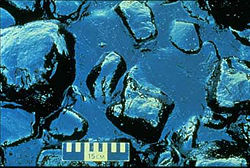Population distribution
Alaska is the least densely populated state in the U.S. with 0.4247 people per square kilometer (1.1 per square mile). Population densities in the other states range from 1.97 per square kilometer (5.1 per square mile) in Wyoming to 438 per square kilometer (1,134.4 per square mile) in New Jersey. Alaska's population was estimated to be 663,661 in 2005.
Alaska's most populous city is Anchorage, home to 277,000 people (2007 estimate)—42 percent of the state's population. The city comprises 5,063 sq. kilometers (1,955 sq. miles)—about the size of the land area of the state of Delaware.[28]
In 2007, Alaska had more than three times the people and five times the jobs it had when it became a state in 1959. More than 60 percent of the population lives in Anchorage and adjacent boroughs. Many of the Alaska natives continue to live in remote villages scattered throughout the state, generally along rivers or the coasts. The lifestyles of those in the cities and those in rural areas are vastly different. Many in the remote areas survive on subsistence farming and fishing and must contend with a lack of safe water and sewer systems. Unemployment in these areas tends to be quite high.
The vast, sparsely populated regions of northern and western Alaska are primarily inhabited by Alaska Natives, who are also numerous in the southeast. Anchorage, Fairbanks, and other parts of south-central and southeast Alaska have many whites of northern and Western European ancestry. The Wrangell-Petersburg area has many residents of Scandinavian ancestry and the Aleutians contain a large Filipino population. Most of the state's black population lives in Anchorage. Fairbanks also has a sizable African American population.
Agriculture and manufacturing
Agriculture represents only a small fraction of the Alaska economy. Agricultural production is primarily for consumption within the state and includes nursery stock, dairy products, vegetables, and livestock. Manufacturing is limited, with most foodstuffs and general goods imported from elsewhere.
Environmentalism
Oil production was not the only economic value of Alaska's land, however. In the second half of the twentieth century, Alaska discovered tourism as an important source of revenue, which had become popular following World War II, when men stationed in the region returned home praising its natural splendor. The Alcan Highway, built during the war, and the Alaska Marine Highway System, completed in 1963, made the state more accessible than it had ever been. Tourism became increasingly important in Alaska, and today over 1.4 million people visit the state each year.
With tourism more vital to the economy, environmentalism also rose in importance. The Alaska National Interest Lands Conservation Act (ANILCA) of 1980 added 53.7 million acres (217,000 km²) to the National Wildlife Refuge system, parts of 25 rivers to the National Wild and Scenic Rivers system, 3.3 million acres (13,000 sq km) to National Forest lands, and 43.6 million acres (176,000 sq km) to National Park land. Because of the Act, Alaska now contains two-thirds of all American national park lands. Today, more than half of Alaskan land is owned by the Federal Government.
Exxon-Valdez
The possible environmental repercussions of oil production became clear in the Exxon Valdez oil spill of 1989. On March 24, the tanker Exxon Valdez ran aground in Prince William Sound, releasing 11 million gallons (42 million liters) of crude oil into the water, spreading along 1,100 miles (1,800 km) of shoreline. According to the U.S. Fish and Wildlife Service, at least 300,000 sea birds, 2,000 otters, and other marine animals died as a result of the spill. Exxon spent $2 billion on cleaning up in the first year alone. Exxon, working with state and federal agencies, continued its cleanup into the early 1990s. Government studies show that the oil and the cleaning process itself did long-term harm to the ecology of the Sound, interfering with the reproduction of birds and animals in ways that still aren't fully understood. Prince William Sound seems to have recuperated, but scientists still dispute the extent of the recovery. In a civil settlement, Exxon agreed to pay $900 million in ten annual payments, plus an additional $100 million for newly discovered damages.
The Alaska SeaLife Center, which opened in May 1998, was established by The Seward Association for Advancement of Marine Science and continues as a collaborative effort between Coastal America, North Pacific Research Board, University of Alaska School of Fisheries and Ocean Sciences, and Ocean Alaska Science & Learning Center.
The Exxon Valdez Oil Spill Settlement Fund provided $26 million to help build the $56 million facility. Grants, bonds and donations supplied the remaining funds, while the city of Seward donated a seven-acre waterfront site.
The center is dedicated to understanding and maintaining the integrity of the marine ecosystem of Alaska through research, rehabilitation, and public education. Visitors are immersed in naturalistic exhibits relating to the marine ecosystems of the state.
Arctic National Wildlife Refuge
Today, the tension between preservation and development is seen in the Arctic National Wildlife Refuge (ANWR) drilling controversy. The question of whether to allow drilling for oil in ANWR has been a political football for every sitting American president since Jimmy Carter. Studies performed by the U.S. Geological Survey have shown that the "1002 area" of ANWR, located just east of Prudhoe Bay, contains large deposits of crude oil.
Traditionally, Alaskan residents, trade unions, and business interests have supported drilling in the refuge, while environmental groups and many within the U.S. Democratic Party have traditionally opposed it. Among native Alaskan tribes, support is mixed. In the 1990s and 2000s, votes about the status of the refuge occurred repeatedly in the U.S. House and Senate, but as of 2007, efforts to allow drilling have always been ultimately thwarted by filibusters, amendments, or vetoes.
http://www.newworldencyclopedia.org/entry/Alaska#Agriculture_and_manufacturing


